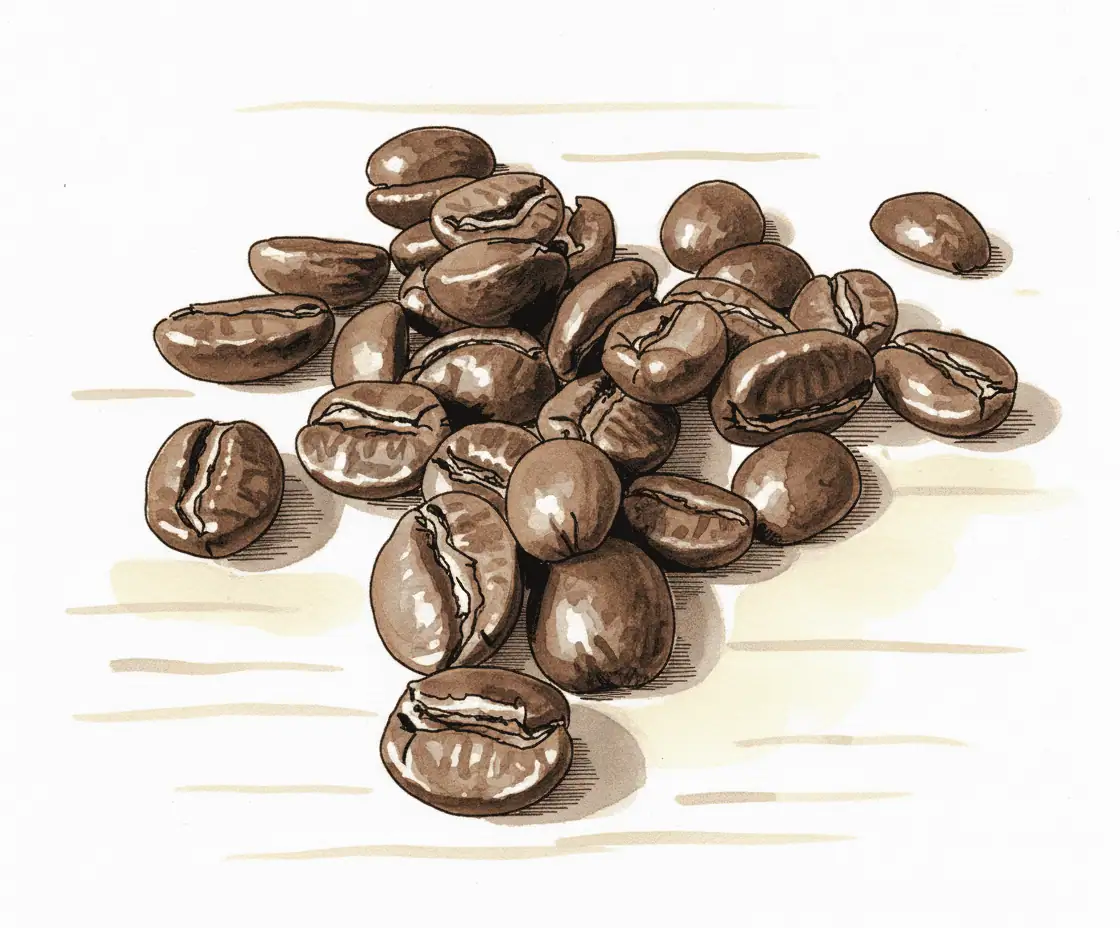High-Altitude Coffee
At high altitudes (above 1500 meters), coffee cherries ripen more slowly, resulting in denser beans with pronounced aromas. The lower temperature and thinner air foster a complex flavor profile, often characterized by high acidity and fruity, floral, or wine-like notes. Regions such as Ethiopia and parts of Latin America are known for their high-altitude coffees, which are prized for their refined and sparkling character.
High‑altitude coffee beans

Candy Shop
De Candy Shop koffie van Finca Las Flores is een uitzonderlijke boon uit Huila, Colombia. Deze Java-variëteit, geproduceerd door de broers Vergara, biedt een rijke smaakervaring met fruitige tonen van Purple Lifesavers en frambozen, en bloemige accenten van lavendel. Deze veelzijdige koffie, die perfect is voor zowel V60-filter als espresso, heeft een levendige zuurgraad en…

Cappuccino Melange
Deze krachtige espresso blend combineert 100 procent Arabica uit Brazilië, Costa Rica, Guatemala en Ethiopië. De medium tot licht donkere branding geeft een volle smaak met tonen van bittere chocolade, cacao, vanille en een bloemig fruitig accent. Door de mix van natuurlijke en gewassen verwerkingen blijft het profiel helder en gebalanceerd. Ideaal voor espresso, cappuccino,…

Caramel Hump
Caramel Hump is een espresso branding van Sprout Coffee Roasters. Deze Pink Bourbon uit San Agustín Huila is washed verwerkt voor een schone kop. Verwacht karamel in het aroma, met groene appel en rustige citrus in de slok. De body is middelvol en de afdronk blijft lang helder.Aanbevolen espressoEspresso 19,5 g in 45 g uit…

Carlos Nuñez
Morning Glory presenteert Carlos Nuñez Natural uit Comayagua, Honduras. Deze Parainema is natural verwerkt met 65 uur droge fermentatie. Verwacht rijpe zoetheid, een volle body en veel gelaagde aroma’s.In de kop proef je cocoa, strawberry jam en een bourbonachtige kruidigheid. De aciditeit is helder en rond, de nasmaak blijft lang en aangenaam. Transparantie over prijs…

Chacra Don Dago – Peru
Chacra Don Dago uit El Palomar toont waarom Peru schittert. Dit honey-verwerkte microlot van Renzo Roastery brengt florale aroma’s, rijpe appel en bergamot, met sprankelende zuren en een schone afdronk. De boerderij werkt Demeter-biodynamisch en gebruikt de variëteit Yellow Obata. SCA 87,25 bevestigt de precisie.Zetadvies: kies filtermethoden die helderheid bewaren. Ideaal voor V60 en Kalita,…

Cheeky Choc Cherry
Cheeky Choc Cherry is een single origin espresso van Sprout Coffee Roasters uit Huila in Colombia. De Caturra variëteit en de washed verwerking geven een cleane kop met gelaagde zoetheid. Verwacht een volle body, middelmatige zuren en een lange, cacaoachtige afdronk.Smaakprofiel, kers, melkchocolade, boterkoek en een vleugje amandelProces, washed voor helderheid en precieze expressie van…

Chelbesa
Deze Chelbesa Yirgacheffe komt uit de Gedeb zone in Ethiopië, verzameld bij Chelbesa One Washing Station en beheerd door SNAP Coffee. Op 1950 tot 2200 meter groeien Korume en Wolisho landrace variëteiten. De koffie is licht tot medium geroosterd voor filter of espresso, met heldere tonen van limoen, honing, bergamot en florale nuances, plus hints…

Chelbesa – Yirgacheffe – Ethiopia
Chelbesa Danche uit Yirgacheffe is licht gebrand door Nordic Roasting Company. De koffie is volledig gewassen, wat zorgt voor helderheid en precisie. Verwacht jasmijn in het aroma, met bergamot en limoen in de eerste slok. Rijpe perzik en soms abrikoos geven zoetheid en diepte. De structuur blijft transparant, met een theeachtig mondgevoel en een lange,…

Cherry Slide – Colombia
Cherry Slide van DAK Coffee Roasters komt uit Tolima. Deze natural barst van zwarte kers, bramenjam en een frisse hint van jeneverbessen. De body is vol en siroopachtig, terwijl de afdronk lang en helder blijft. Dit profiel werkt verrassend goed in filter en espresso.Geschikt voor V60, Kalita en Chemex.Richtverhouding 1:15 tot 1:17, afhankelijk van maling…

Chiapas
Engrano Chiapas komt uit de staat Chiapas in zuidelijk Mexico, waar koffie groeit op vulkanische bodem in de Reserva El Triunfo op 1200 tot 1800 meter. De bonen zijn 100 procent Arabica met variëteiten Mundo Novo en Bourbon, gewassen verwerkt voor een schone, complexe kop. De lichte branding benadrukt een medium body met proefnotities van…

Chimi
Chimi is de eigen blend van SOCOCO met bonen uit Guatemala en Uganda. De blend, vermoedelijk medium roast, brengt tonen van chocolade, noten en een lichte fruitigheid samen. De washed verwerking benadrukt helderheid en zuiverheid, waardoor de smaak zacht en toch gelaagd blijft. SOCOCO legt de nadruk op sociale impact en transparantie in de keten,…

Chinchilla
Chinchilla van Keen komt van Monserrath Chinchilla in Los Santos, Tarrazú. De natural verwerking met gecontroleerde fermentatie en langzaam drogen levert helderheid en gelaagde zoetheid. Verwacht kers, pure chocolade en een cola-achtige finish. Het profiel blijft levendig en rond, met medium body. Deze microlot is beschikbaar als lichte filter- en espressorost, in 250 en 1000…

Chuqibamba
Chuqibamba is een community lot uit Cajamarca in het noorden van Peru. Kleine boeren telen op 1500 tot 1800 meter, met koele nachten en mist. Na de pluk worden de bessen ontpulpt, 24 tot 30 uur gefermenteerd en vervolgens 15 tot 20 dagen langzaam gedroogd. Branderij Luijendijk kiest een medium roast, gericht op een gebalanceerde…

City Limits
City Limits is een espresso blend met 70 procent Brazilië Inacio Soares F2 en 30 procent El Salvador Rodolfo Ruffati Red Bourbon. De bonen groeien tussen 880 en 1650 meter en worden verwerkt met honey en gewassen methodes voor een balans tussen zoetheid en helderheid. De medium tot medium donkere roast benadrukt tonen van donkere…

Classy Cassy
De Classy Cassy is een uitzonderlijke koffie van WanRich Coffee, geteeld op de vruchtbare bodem van Kitale, Kenia. Deze SL28-variëteit biedt een levendig smaakprofiel met citrustonen en een cassisachtige frisheid. Dankzij de gewassen methode heeft de koffie een heldere, frisse smaak. Sprout Coffee Roasters raadt aan de Classy Cassy te zetten met de V60-methode voor…

Coco Choco
Coco Choco is een micro-release van Sprout Coffee Roasters uit Palestina, Huila. De boon is vooral Pink Bourbon en wordt verwerkt als “Open Fermentation Extended Washed”. Dat levert een glasheldere kop met hoge zoetheid op. Verwacht tropische geur zoals piña colada, een romige yoghurttextuur en een zachte finish van melkchocolade. De filterbrand is ontworpen voor…
High Altitude (above 1500 meters)
Welcome to the world of high-altitude coffee! When you think of beans grown above 1500 meters, words like “refined,” “complex,” and “vibrant” often come to mind. But why exactly? In this article, we’ll dive into the effects of high altitudes on your espresso, the chemical composition of the beans, processing methods, and much more.
How altitude affects espresso flavor
At high altitudes, coffee cherries mature more slowly. This gradual ripening process allows sugars and acids in the fruit to develop over time, giving the beans ample opportunity to build a full range of flavors. When you use these beans for espresso, you’ll often taste a refined acidity and floral or fruity characteristics—think subtle citrus or berry aromas with a bright, almost “sparkling” quality. If you enjoy a delicate espresso, high-altitude beans are an excellent choice.
Chemical composition: density, sugars, and acids
Because the air is thinner and cooler at higher elevations, coffee trees receive less oxygen and grow at a slower pace. This results in denser beans that often exhibit higher acidity. The sugars develop more gradually, and the extended ripening contributes to a complex flavor structure. You end up with a bean that balances sweetness and complexity, translating into a lively cup of coffee. The increased density also impacts roasting profiles: roasters usually take extra care to highlight all those nuanced flavors.
Processing methods at high altitude
Thanks to the cooler, sometimes more humid climate, some coffee farmers opt for processing techniques that emphasize their beans’ unique characteristics. In many high-altitude regions, the washed method is especially popular, as it accentuates fruity and floral notes. Removing the pulp and mucilage under carefully controlled conditions allows any impurities to wash away, leaving a clean, pure flavor. There’s also some experimentation with natural and honey processes in these regions, though washed processing is often the standard for maintaining clarity.
Climate and microclimate
High-altitude environments have unique weather conditions: cooler nights, milder days, and often more rainfall. In some places, mist clings to the mountainsides, creating microclimates that can vary even from one slope to the next. This contributes to the slow ripening of cherries and the development of complex aromas. On the flip side, coffee farmers face challenges like fungal diseases in damp conditions, but the reward is a flavor profile cherished worldwide.
Yield and resilience
Growing coffee at 1500 meters or higher isn’t easy. The trees often produce fewer cherries because the plants expend more energy just to survive in cooler temperatures. Still, the beans command a premium for their pronounced quality and distinctive taste. Many farmers form cooperatives to share knowledge about cultivating coffee under these challenging conditions, employing innovative irrigation methods or using shade trees to protect their coffee plants.
Choosing coffee varieties
Not all coffee plants thrive at 2000 meters. Farmers often select varieties that can handle the cold and resist diseases, such as certain Arabica strains (like Bourbon, Typica, or Geisha). These varieties are known for their potential to develop subtle flavor nuances—a perfect match for the special circumstances high altitudes provide.
All in all, coffee from high altitudes isn’t just any cup of joe. Expect floral notes, a lively acidity, and refined aromas that will delight anyone seeking a bright and complex coffee experience.
